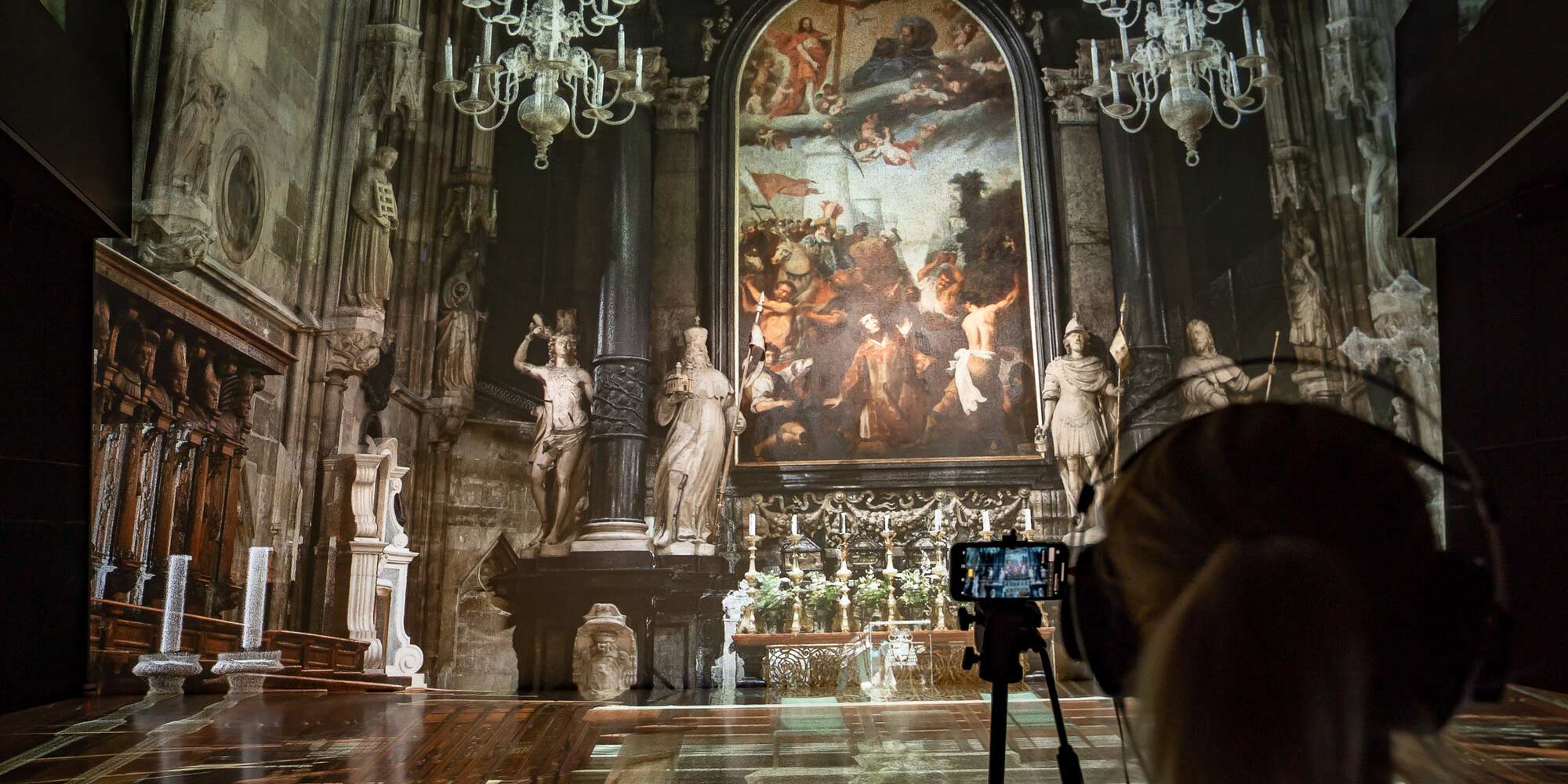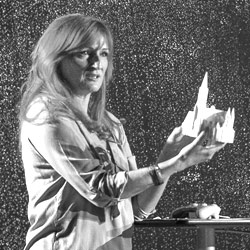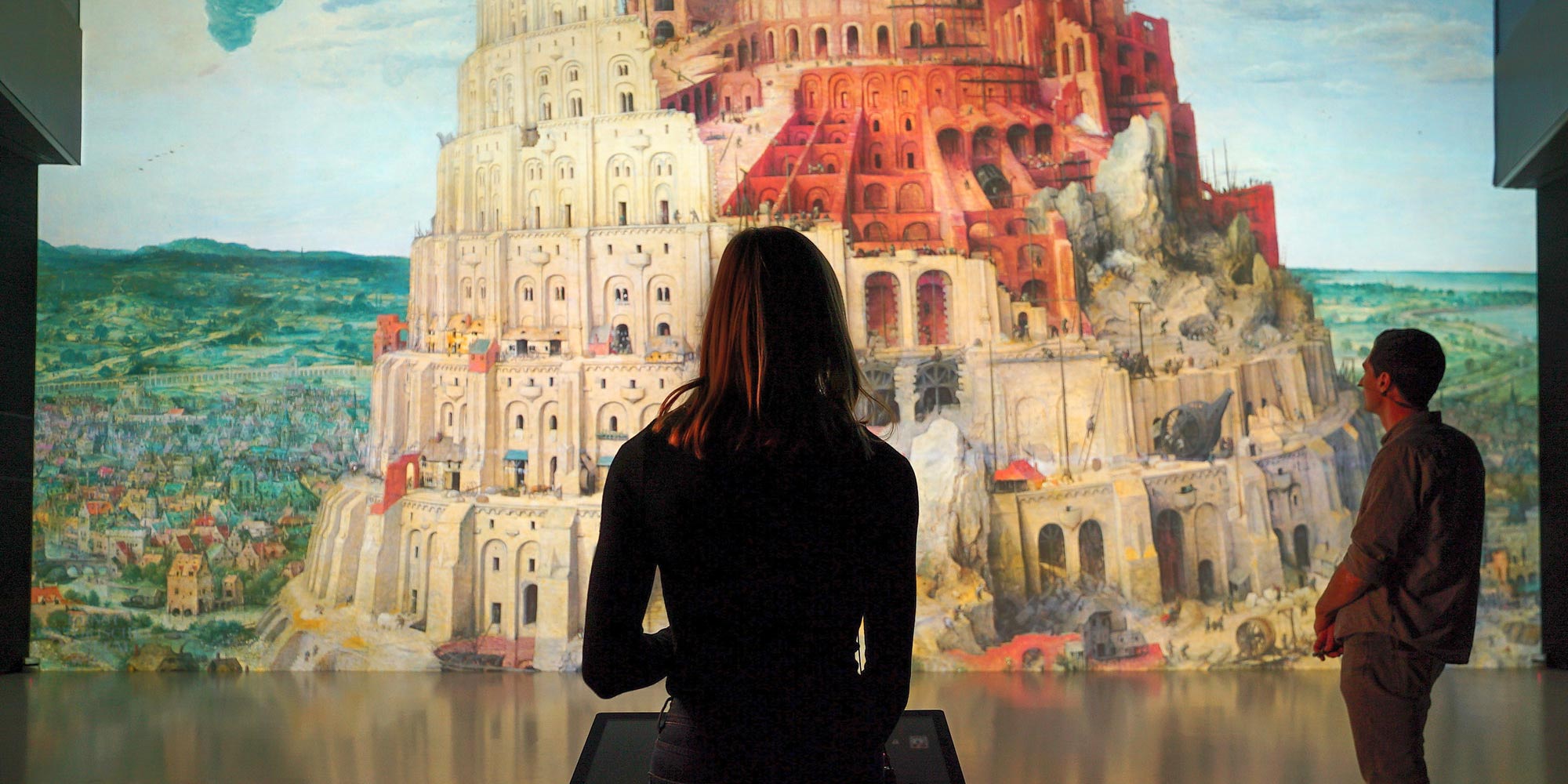Gustav Klimts „The Bride“, Venus of Willendorf, Vienna’s St. Stephen’s Cathedral. They are all world-famous highlights that Michaela Obermayer presents on her daily virtual tours across European art and cultural history. Countless of what UNESCO defines as “cultural heritage” is stored in digital form on the hard drives of Deep Space 8K. A great virtual treasure of motifs and stories of a region we now call Europe.

The projectors in the Ars Electronica Center Linz’s Deep Space have been running since 2009. Every day, infotrainers take visitors on virtual journeys through impressive visual worlds, using the sophisticated high-tech composition developed by the Ars Electronica Futurelab with its wall and floor projections, each measuring an impressive 16 by 9 metres.
“Virtually”, the digital copies of these art and cultural treasures, otherwise scattered across this continent, are gathered in one place. They are replicas of objects that have shaped today’s Europe in exemplary fashion. The thought, discourse and science of Greek antiquity are as much a part of this canon as the supremacy of religious views from the Middle Ages. Virtual reality here is more than just a three-dimensional, computer-generated, visual copy of reality. Here in Deep Space 8K, it is about the immersive experience of Europe’s cultural heritage, and thus always about broadening one’s own horizons.

“It’s the big projection screens, there’s no all around and the real world fades out for a short time. The room is dark and the wall and floor projections form the frame of another reality”. Michaela Obermayer knows what she is talking about. She has been working at the Ars Electronica Center for 20 years and during this time she has not only guided thousands of people through virtual spaces, but has also made use of many different technological developments.
„Of course you can also watch the Venus of Willendorf at home on your own big-screen TV or with VR glasses. But you’re sitting alone on the couch in your living room. Our Deep Space 8K is all about discovering art and cultural treasures together. And that’s what makes getting to know our cultural heritage so exciting.“
Meanwhile, her gaze is fixed on a high-resolution gigapixel image of a world-famous painting by Pieter Bruegel the Elder. “A visionary work,” Michaela Obermayer enthuses about the Tower of Babel, as the Dutchman painted it in 1563. “What a parable also for our world today and for a problem that is as human as it is timeless.”
Stories and the stories behind the stories – that’s what communicating cultural heritage in Deep Space 8K is all about. Transforming a physical object into a virtual model is only the first step. So the infotrainers in the Ars Electronica Center not only have the controls in their hands when presenting, with which they take the audience on a journey through three-dimensional worlds, high-resolution gigapixel images, detailed laser scans and house-sized animations. They acquire the knowledge beforehand in joint training sessions, provide context and ask questions.
“For me, it is always very important to include the comparative”. Michaela Obermayer studied fine arts education and art history and developed a critical eye for the visual: “What was being created elsewhere at the same time? Which societies produced what and why? What were the themes of the time and its artists? How did their works express or even question and shake the prevailing view of the world and of humanity? And do the reverberations of this debate perhaps even reach into our own time?

The circular Ebstorf world map from the Middle Ages with its numerous details shows a different picture: “When our visitors see this map, they become aware not only of how little the people of the 13th century knew of the world, but above all how unimaginably much we know today. The foundations of this world view recorded here were narratives that were handed down from many different sources and were always in a state of flux. Even paradise and various scenes from the Bible are included here.”
Art and cultural treasures can also be rediscovered thanks to new technologies such as VR. Because they always make other facets and details visible, which in turn promote new perspectives and a better understanding – not only of the works of art, but ultimately also of ourselves. Reflecting on what it means to be human makes art a kind of compass.
“Our fundamental problems and challenges have not changed much. They just appear to us today in a different dress, which is why art is so timeless.”
A woman smiles. Leonardo da Vinci’s “Mona Lisa” beams all over the room. “I especially like to ask children and young people if they like the ‘Mona Lisa’. After a quiet murmur, I then explain that 500 years ago that was the epitome of a beautiful woman. And we’re already in the middle of the discussion about today’s ideals of beauty and their staging on Instagram, Tik Tok and the like.”

Credit: Ars Electronica / Martin Hieslmair
While museums, archives, libraries and universities have been collecting, preserving and displaying art and cultural treasures for hundreds of years in the form of large, very elaborate exhibitions, the virtual presentation of art and cultural treasures opens up a virtually light-hearted and easy, but for that very reason also very inspiring, foray right through art and cultural history. “Works of art, buildings, paintings, pieces of music – everything is part of our history and explains why we live the way we do today. Amidst the immersive visual worlds, we can learn about this in Deep Space 8K in an exciting and fun way – and walk out a bit smarter at the end.”
The next presentation begins. Michaela Obermayer opens the door and the visitors crowd into Deep Space 8K. Virtual reality doesn’t always have to be pure entertainment or pure gimmickry to inspire people.

Michaela Obermayer has been working at the Ars Electronica Center Linz in the Visitor Experience department since 2002 and has been responsible for the theme and project management of Deep Space 8K since 2012. She studied Art Education and Technical Work at the Linz University of the Arts and Philosophy and Art Studies at the KTU Linz. In addition to her professional activities, she has been active as DJ Nancy O. since the 1990s and participates as an actress in the theatre association Turm 20.
Programme information: Explore the hidden passages and chambers of the Cheops Pyramid, wander through Vienna’s St. Stephen’s Cathedral and learn interesting details about its history, inspect every last brushstroke of Gustav Klimt’s portraits of women or get to know visually stunning media art works. Deep Space EVOLUTION offers visitors to the Ars Electronica Center on Saturday May 7, 2022, and Sunday May 8, 2022, a wide-ranging programme that extends from art of antiquity to that of the present day. More on ars.electronica.art/center.
